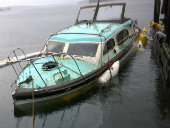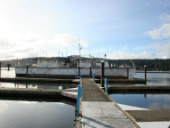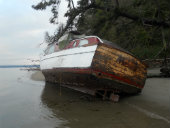


Washington's 2001 Legislature authorized the use of money in the state toxics account for a grant program for local governments to clean up and dispose of hazardous substances on abandoned and derelict vessels. The grant is administered by the state Department of Ecology.
The 2002 Washington State Legislature then passed the Derelict Vessel Act, which provides certain local and state agencies with the authority and funding for the removal and disposal of derelict and abandoned vessels from the waters of the state.
We need everyone's help to identify and locate derelict vessels. If you would like to report a vessel, please download the Reporting Form and fill out the form with as much information as possible, and then email, fax, or mail it to the Derelict Vessel Removal Program.
History
The first effort to address derelict and abandoned vessels came when Washington's 2001 Legislature authorized the use of money in the state toxics account for a grant program for local governments to clean up and dispose of hazardous substances on abandoned and derelict vessels. The 2002 Washington State Legislature then passed the Derelict Vessel Act, which provides certain local and state agencies with the authority and funding for the removal and disposal of derelict and abandoned vessels from state waters.
Agency Roles
DNR is manager and steward of 2.6 million acres of state-owned aquatic lands. Prior to the 2002 legislation, DNR had to rely on cooperation by the vessel owners, lengthy legal approaches such as trespass and nuisance abatement actions, and federal actions to address derelict vessels. Both the United States Coast Guard and the Army Corps of Engineers have federal authority to address derelict and abandoned vessels, but that authority is constrained. The Coast Guard addresses vessels that pose a substantial pollution threat or threat to federal navigation channels. These problems usually are mitigated without removing and disposing of the vessel (by removing the majority of the pollutants or moving the vessel out of the navigation channel, respectively), and the Coast Guard does not have authority to remove and dispose of a vessel once the immediate threat has been removed except in rare cases. Likewise, the Corps has authority to remove floating or sunken debris, but only if that debris is a hazard to navigation in a federally maintained navigation channel.
DNR has created an inventory of derelict and abandoned vessels in the waters of Washington State. In addition, criteria have been developed to prioritize expenditures from the derelict vessel removal account. Because the funding of the derelict vessel removal account is limited each year, these criteria include consideration of environmental protection, threats to human health and safety, as well as threats to navigation, so the most damaging vessels can be removed first. Vessels may also be removed through other funding sources that don’t require adherence to the prioritization.
How the Derelict Vessel Removal Program Works
An Authorized Public Entity - most of which are public agencies that own or manage aquatic lands - has the discretionary authority to remove and dispose of a vessel within its jurisdiction that has become abandoned or derelict. These authorized entities are: state Departments of Natural Resources, Fish and Wildlife, Parks and Recreation Commission (State Parks); metropolitan park districts; port districts; and any city, town, or county with aquatic ownership. Washington's DNR manages the program, maintains vessel inventory, and facilitates other agencies' removal and disposal actions. As an Authorized Public Entity, DNR also removes vessels from state-owned aquatic lands. If a vessel is not on state-owned aquatic lands, DNR still may act with permission of an agency with regulatory jurisdiction over the area.
Taking Action on a Derelict or Abandoned Vessel
There are two ways that a public entity can take action on a vessel - temporary possession and/or custody. Temporary possession is an emergency action. If a vessel is in immediate danger of sinking, breaking up, blocking navigation channels or posing an imminent threat to human health or safety, including the threat of environmental contamination, a public entity may take control of the vessel to mitigate the posed threat if the owner is unwilling or unable to do so. Temporary possessions are followed by the custody procedure described below, unless the vessel owner takes responsibility for the vessel, which includes paying any costs owed.
Prior to taking custody of a vessel, the public entity must attempt to notify the vessel's owner (if known) of its intent to remove the vessel. Notice must be mailed to the last known address of the owner on record, posted clearly on the vessel, printed in a newspaper in the county in which the vessel is located, and published on DNR's website. All notices must include information specified in RCW 79.100.400, including the procedures that must be followed to reclaim possession of the vessel, the owner's possible financial liabilities, and the rights of the authorized public entity after custody of the vessel is obtained.
Once the Authorized Public Entity takes custody of a vessel, that entity may use or dispose of the vessel in any environmentally sound manner with preference given for methods that derive value from the vessel. If a monetary value can be derived, then that amount will be subtracted from the costs incurred by the response to the vessel. If the vessel sells for more than is owed, the profit goes to pay off any liens on the vessel and the remaining funds go back in to the Derelict Vessel Removal Account. If the vessel has no salvageable value, then the public entity must use the least-costly environmentally sound reasonable disposal option.
Owner Responsibility
The owner of a derelict or abandoned vessel is responsible for reimbursing the authorized public entity for all costs associated with the removal and disposal of that vessel. These costs include administrative costs and costs associated with any environmental damage caused by the vessel.
An owner seeking to redeem a vessel that is in the custody of an authorized entity, or wishing to contest the amount of money owed, must bring an appeal action within the appeal period. The appeal period is 30 days, unless described otherwise in the custody notice (for agencies that have set up an appeals process in local law, they would use that procedure) RCW 79.100.120. If an appeal is not filed in a timely manner, the right to a hearing will be waved. In addition to being responsible for costs, people who cause a vessel to become abandoned or derelict on the waters of the state may also be found guilty of a criminal misdemeanor. (RCW 79.100.110).
Moorage Facilities
In addition to being addressed in the Derelict Vessel Act, vessels at moorage facilities are covered by state laws specific to the particular type of facility. Public moorage facilities are covered by the Port Moorage Facilities RCW 53.08. If a public moorage facility has an abandoned vessel, they may still follow their existing procedures for removal and then request reimbursement from the Derelict Vessel Removal Account. Private moorage facilities are covered by RCW 88.26. Under the statute, they may seize a vessel for nonpayment of rent but they cannot receive Derelict Vessel Removal Program funds unless they contract with the local Authorized Public Entity for removal of the vessel and the Authorized Public Entity seizes the vessel. The public entity is eligible for the funds.
Marinas
New laws related to marina and vessel insurance passed during the 2013/2014 legislative session. Find more information here.
For more information see the Derelict Vessel Removal Program Guidelines. Sample custody postings are included in the Guidelines.

